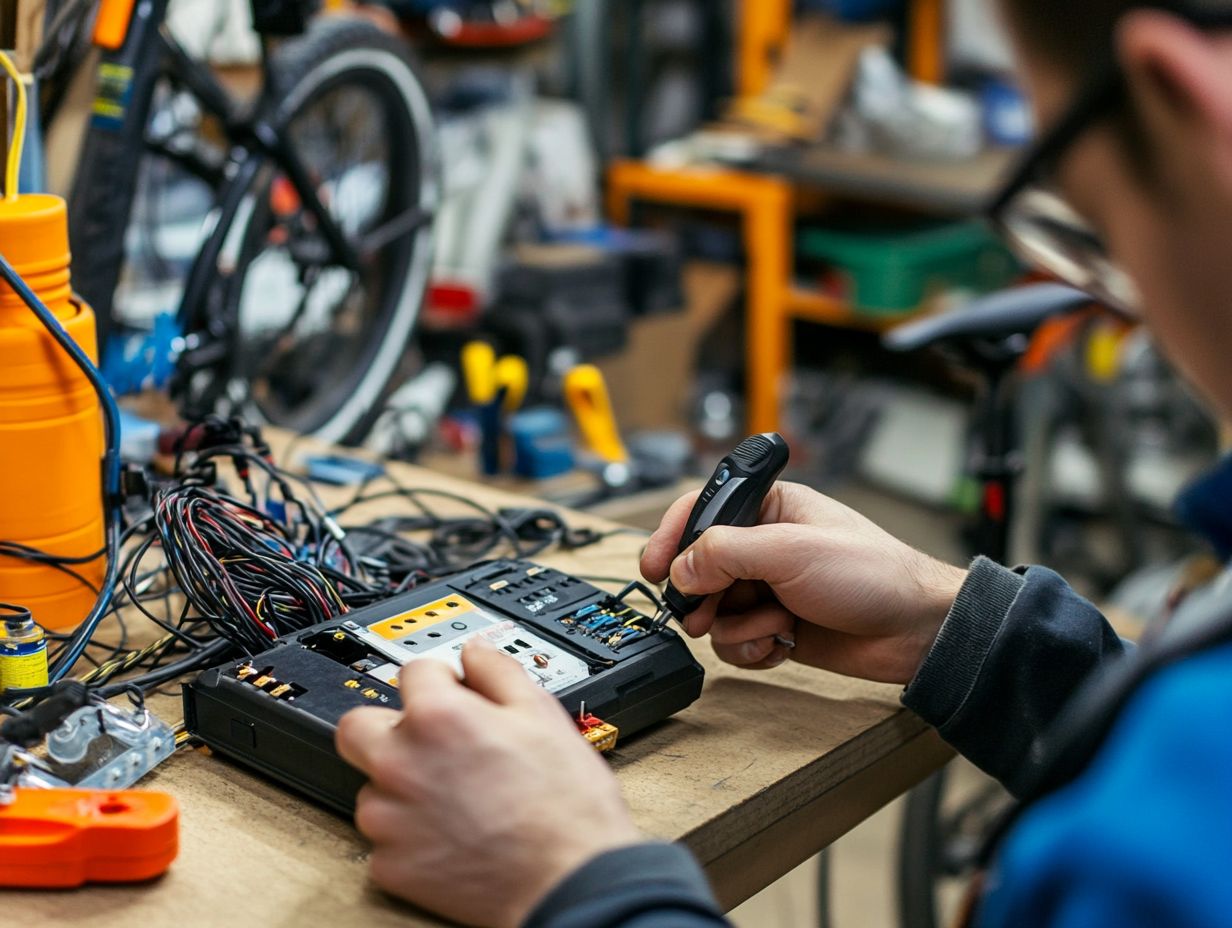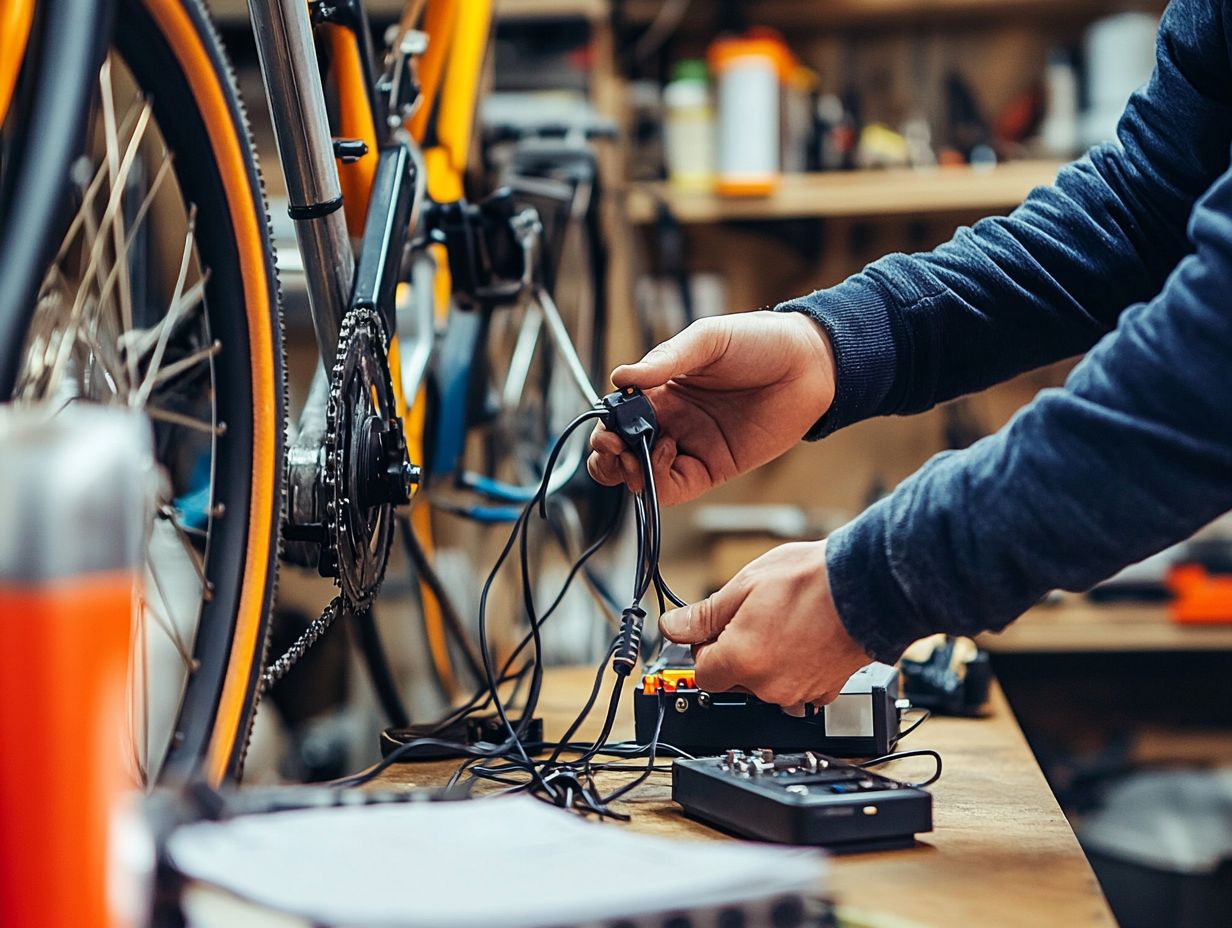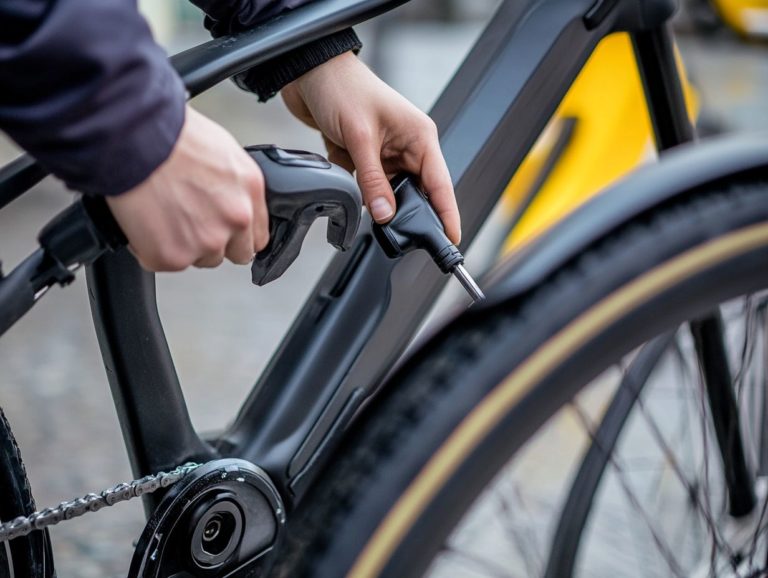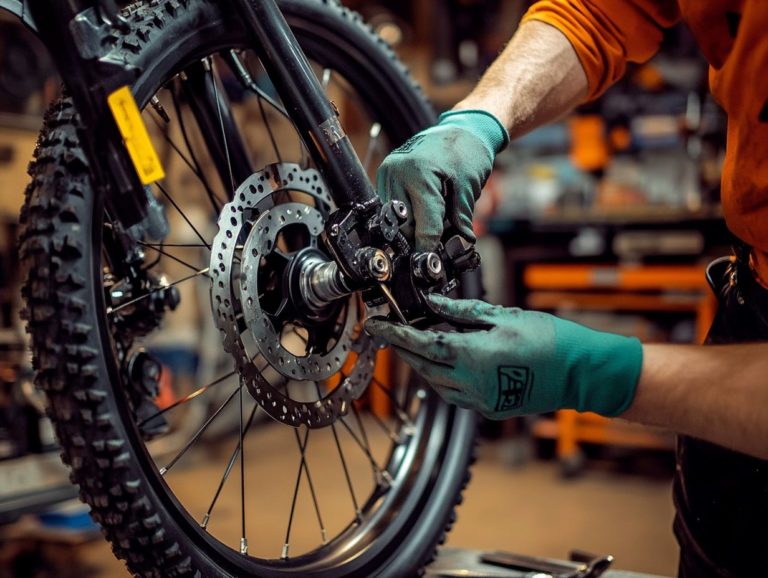How to Troubleshoot Electric Bicycle Electrical Issues
Electric bicycles have transformed your commuting experience, providing an eco-friendly and efficient mode of travel. However, like any technology, they can run into electrical issues that might leave you feeling stranded or frustrated.
This guide delves into common electrical problems, equipping you with the knowledge to identify the source of the issue. It offers tools and techniques for effective troubleshooting, outlines preventive measures to ensure your e-bike runs smoothly, and advises you on when to seek professional assistance.
Whether you re a seasoned cyclist or a new owner, this guide empowers you to maintain your electric bicycle with confidence.
Contents
- Key Takeaways:
- Diagnosing Electric Bicycle Electrical Issues
- Tools and Techniques for Troubleshooting
- Preventive Measures for Maintaining Electric Bicycles
- Professional Help for Electric Bicycle Electrical Issues
- Frequently Asked Questions
- What are some common signs of electric bicycle electrical issues?
- How can I determine if the battery is the cause of the issue?
- What should I do if my electric bicycle suddenly loses power?
- How do I troubleshoot flickering lights on my electric bicycle?
- Why is my electric bicycle making unusual noises?
- Is it safe to troubleshoot electric bicycle electrical issues on my own?
Key Takeaways:

- Regular maintenance and proper usage can prevent most electric bicycle electrical issues.
- Diagnosing the source of the problem and using the right tools and techniques are key to troubleshooting successfully.
- Knowing when to seek professional help can save time and ensure safety when dealing with complex electrical issues.
Diagnosing Electric Bicycle Electrical Issues
Diagnosing electrical issues in your electric bicycle is crucial for maintaining both its longevity and peak performance, whether you’re riding a Velotric or another top-tier model.
Common problems you might encounter include:
- a battery that refuses to charge
- a controller that’s gone mute
- a throttle that doesn’t respond
- a pedal assist system that simply won’t engage
By familiarizing yourself with these potential issues, you can pinpoint the root of the problem and implement effective troubleshooting steps, such as those outlined in our guide on troubleshooting electric bicycle battery issues, before turning to professional help. This proactive approach not only gives you the power but can also save you both time and money when it comes to bike repairs.
Common Electrical Problems
Common electrical problems in e-bikes, like a battery that refuses to charge or a controller that s gone rogue, can seriously disrupt your cycling experience and compromise your safety. It s essential to be aware of these potential issues. If you notice throttle or pedal assist issues, these could be signs of underlying wiring problems or issues with electrical components that demand your immediate attention.
As a rider, you might find yourself grappling with erratic display readings or sudden power losses while cruising, which could result in unexpected stops or even complete system failures. These frustrating symptoms often arise from loose connections, degraded wire insulation, or a display unit that s seen better days.
Ignoring these problems not only hampers your performance but can also lead to more severe malfunctions down the line. By understanding these potential electrical glitches, you can take proactive measures to ensure smoother rides and enhance both the safety and longevity of your e-bike.
Don’t wait! Routine inspections are key to keeping your ride safe and reliable. Timely diagnosis and repairs are crucial for maintaining the functionality and reliability of your e-bike.
Identifying the Source of the Problem
Identifying the source of a problem in your electric bike demands a step-by-step process to troubleshooting that effectively pinpoints the issue. Begin by checking your controller and throttle for any signs of malfunction.
Next, check the battery connections, keeping an eye out for loose wires or poor voltage. Using a voltmeter (a tool that measures electrical voltage) will help you detect any battery performance issues. For more detailed guidance, refer to how to perform electric bicycle wire inspections. Monitoring the LED lights can provide valuable insights into your e-bike’s overall functionality.
Once these initial checks are complete, it’s wise to inspect the wiring harness for any visible damage or corrosion, as these factors can often disrupt electrical flow. Test the throttle by disconnecting it and measuring the resistance with a voltmeter to ensure it falls within the manufacturer’s specifications.
Engaging with your e-bike’s manual will offer crucial guidance on proper voltage readings, further narrowing down where the fault may lie. Additionally, being aware of the signs your electric bicycle needs immediate repair can help you address issues promptly. By following these steps, you will gain a comprehensive understanding of the bike’s electrical system.
Tools and Techniques for Troubleshooting

Using the right tools and techniques for troubleshooting your e-bike can transform a minor inconvenience into a swift resolution. This prevents lengthy repairs.
Essential tools at your disposal include:
- a voltmeter for measuring battery voltage,
- a reliable battery charger to keep your battery charged,
- and different tools to check electrical parts, such as wiring issues that might impede performance.
A well-crafted DIY troubleshooting guide can equip you to handle minor issues confidently. This ensures your electric bicycle remains in peak condition.
Essential Tools for DIY Troubleshooting
A comprehensive DIY troubleshooting guide for e-bikes begins with your grasp of essential tools needed for effective repairs. You ll want a voltmeter to measure battery voltage and a reliable battery charger to keep your electric bike ready for the road.
Don’t overlook basic tools like screwdrivers and wrenches; they re vital for accessing electrical components and making necessary repairs.
A torque wrench is also essential for tightening bolts to the manufacturer s specifications. This careful approach prevents over-tightening, protecting your bike’s important parts!
A tire pressure gauge is another must-have tool. It allows you to monitor tire inflation levels for optimal performance and safety.
Add a multi-tool designed for bicycles to your toolkit. It streamlines tasks by offering various functions, from adjusting gear-changing parts to changing flat tires. Local bicycle shops and online retailers offer a variety of these tools, often featuring starter kits tailored for e-bike maintenance. This ensures you have everything needed to keep your ride in peak condition.
Step-by-Step Troubleshooting Process
The step-by-step troubleshooting process for your e-bike involves a series of systematic checks to address common issues. Begin by examining your controller and throttle. Next, inspect the battery connections and wiring.
Make sure all parts work well. This helps fix current issues and maintains your e-bike.
Then, check the brakes and tires, as they are crucial for safety and performance. Look for wear and proper inflation.
Next, consider the display panel. Ensure it shows accurate readings and responds to your inputs. If you find any irregularities, a simple system reset might resolve minor glitches.
Regular cleaning and lubrication of the chain and derailleur will enhance performance and prevent future problems. This makes your e-bike rides smoother and more enjoyable. By diligently following these checks, you ll build a solid understanding of your e-bike s operation and help maintain its longevity.
Preventive Measures for Maintaining Electric Bicycles
Implementing preventive measures for maintaining your electric bicycle elevates safety and extends your e-bike s lifespan. This guarantees a dependable riding experience.
Conduct regular checks on the battery management system, brakes, and wiring. This can avert common e-bike issues like brake failure or electrical malfunctions.
Don t wait! Taking these proactive steps to nurture your high-quality e-bike will help you sidestep future complications and enhance its overall performance.
Tips for Avoiding Electrical Issues

To prevent electrical issues with your e-bike, it’s essential to adopt effective maintenance practices for longevity and safety. Regularly inspecting the battery management system (the system that controls battery charging and usage), checking for wiring issues, and assessing overall electrical components can help you avoid common problems, leading to a smoother cycling experience.
Prioritize scheduled maintenance checks every few months to evaluate battery health and connection integrity.
Using the manufacturer’s recommended charger and unplugging once fully charged can significantly reduce wear and tear on your system.
Be mindful of environmental factors as well; riding in extreme temperatures or wet conditions can adversely affect electrical performance. By following these thoughtful guidelines, you’ll not only enhance your riding experience but also minimize the risk of potential electrical disruptions.
Professional Help for Electric Bicycle Electrical Issues
When you encounter electrical issues with your electric bicycle that DIY troubleshooting cannot resolve, seeking professional help can be invaluable. Complex problems often need help from experienced bike mechanics.
These professionals possess the knowledge, including an understanding of common e-bike problems and tools necessary to accurately diagnose and address e-bike repairs, such as how to fix common electric bicycle noise problems, ensuring your electric bike remains both safe and reliable for your journeys.
When to Seek Professional Assistance
Knowing when to seek professional assistance, especially for complex electrical components for your e-bike, can save you both time and money down the road. If common e-bike problems keep coming back, or if the thought of diagnosing electrical components makes you uneasy, reaching out to experienced bike mechanics is a wise choice.
Several key indicators signal the necessity for professional diagnostics, such as:
- Battery issues
- Charging port problems if the battery is not charging
- Checking the battery’s connections and overall health management system assessments
For instance, if you notice a significant drop in battery life or issues like battery not charging, or hear strange noises while riding, these may indicate mechanical malfunctions that require immediate attention.
Fix these recurring issues now to keep your e-bike running smoothly! Skilled technicians have the tools and expertise to conduct precise diagnostics and repairs, allowing you to enjoy your rides with peace of mind, knowing the bike repairs are handled by experienced bike mechanics, free from the worry of unexpected breakdowns.
Frequently Asked Questions
What are some common signs of electric bicycle electrical issues?

- Dead battery
- Flickering lights
- Loss of power
- Unusual noises from the motor or battery
How can I determine if the battery is the cause of the issue?
You can use a multimeter to test the voltage of the battery. If the reading is significantly lower than the recommended voltage, it may be time to replace the battery.
What should I do if my electric bicycle suddenly loses power?
First, check the battery to make sure it is fully charged. If the battery is not the issue, check the connections between the battery and the motor to ensure they are secure. It could also be a problem with the motor itself.
How do I troubleshoot flickering lights on my electric bicycle?
Flickering lights often indicate loose connections or battery problems. First, check all connections to ensure they are secure.
If the connections are fine, test the battery and the controller, which manages power to your bike s systems.
Why is my electric bicycle making unusual noises?
Unusual noises might mean a loose chain or a damaged motor. Inspect these parts carefully.
If you find any issues, make the necessary repairs or replacements to get your bike running smoothly.
Is it safe to troubleshoot electric bicycle electrical issues on my own?
If you’re familiar with electrical systems, you can troubleshoot your electric bicycle safely. If you’re unsure, it s best to get help from a professional to avoid any risks.






